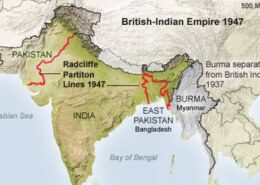Analyze the rise of alternative administrations amid the 1942 Quit India Movement and emphasize how they aided in hastening India’s independence process.
The Indian Independence Act of 1947 stipulated that British India would be partitioned into two dominions- India and Pakistan on religious lines in Northwest India (mainly Punjab) and the province of Bengal. The responsibility of drawing a border along the provinces of Bengal and Punjab was bestowedRead more
The Indian Independence Act of 1947 stipulated that British India would be partitioned into two dominions- India and Pakistan on religious lines in Northwest India (mainly Punjab) and the province of Bengal. The responsibility of drawing a border along the provinces of Bengal and Punjab was bestowed upon Sir Cyril Radcliffe with a time frame of just 5 weeks to complete the task.
The major issues with this decision were:
- Radcliffe had never been to India before and was unfamiliar with the administration in the country.
- Radcliffe was a lawyer by profession and had none of the specialized knowledge and skills required for the task at hand.
- Due to the short period of 5 weeks, there was no time to gather the survey and information about the concerned territories.
- The presence of the United Nations which would have presented Radcliffe with experts and advisers, was deliberately avoided to avoid any delays in the process.
- Radcliffe did not feel comfortable with the Indian climate and showed a desire to leave as quickly as possible.
- To avoid conflicts, the division of territories was done in secret and the final boundaries weren’t presented until two days after the partition.
- Radcliffe believed that people would suffer indifferently to any actions of his and thus justified the casual division.
This resulted in the Radcliffe line which partitioned India and led to the biggest migration in history, being drawn hastily and rather casually. The entire process was ignorant and lacked any form of clinical precision.
See less

The Quit India Movement, launched in 1942, was a critical mass civil disobedience movement aimed at ending British rule in India. One striking feature was the emergence of parallel governments in various regions, which offered a glimpse of self-governance and accelerated India's march towards indepeRead more
The Quit India Movement, launched in 1942, was a critical mass civil disobedience movement aimed at ending British rule in India. One striking feature was the emergence of parallel governments in various regions, which offered a glimpse of self-governance and accelerated India’s march towards independence.
Emergence of Parallel Governments During the Quit India Movement of 1942
Influence of parallel governments in accelerating India’s journey towards independence
The emergence of parallel governments during the Quit India Movement not only exemplified the Indian capability for self-governance but also acted as a catalyst in speeding up the process towards independence. These parallel governments, albeit short-lived, created a blueprint for an independent India and hastened the end of British rule.
See less